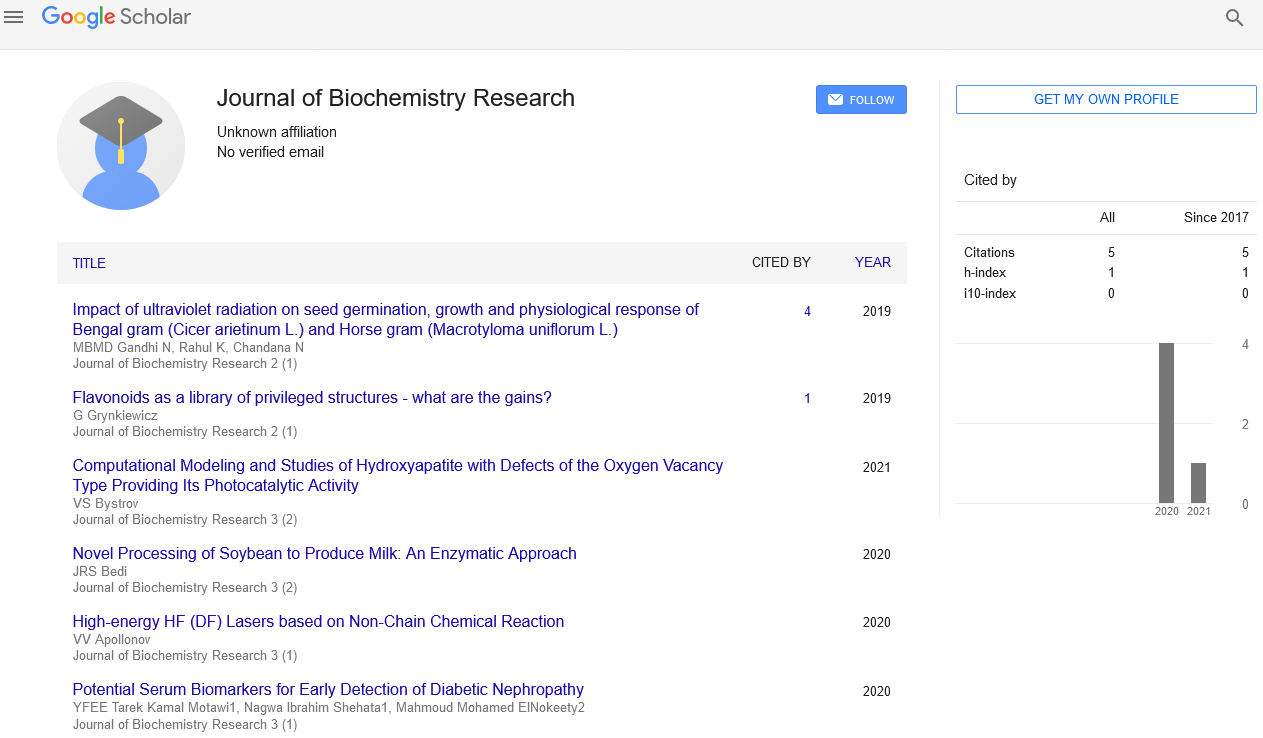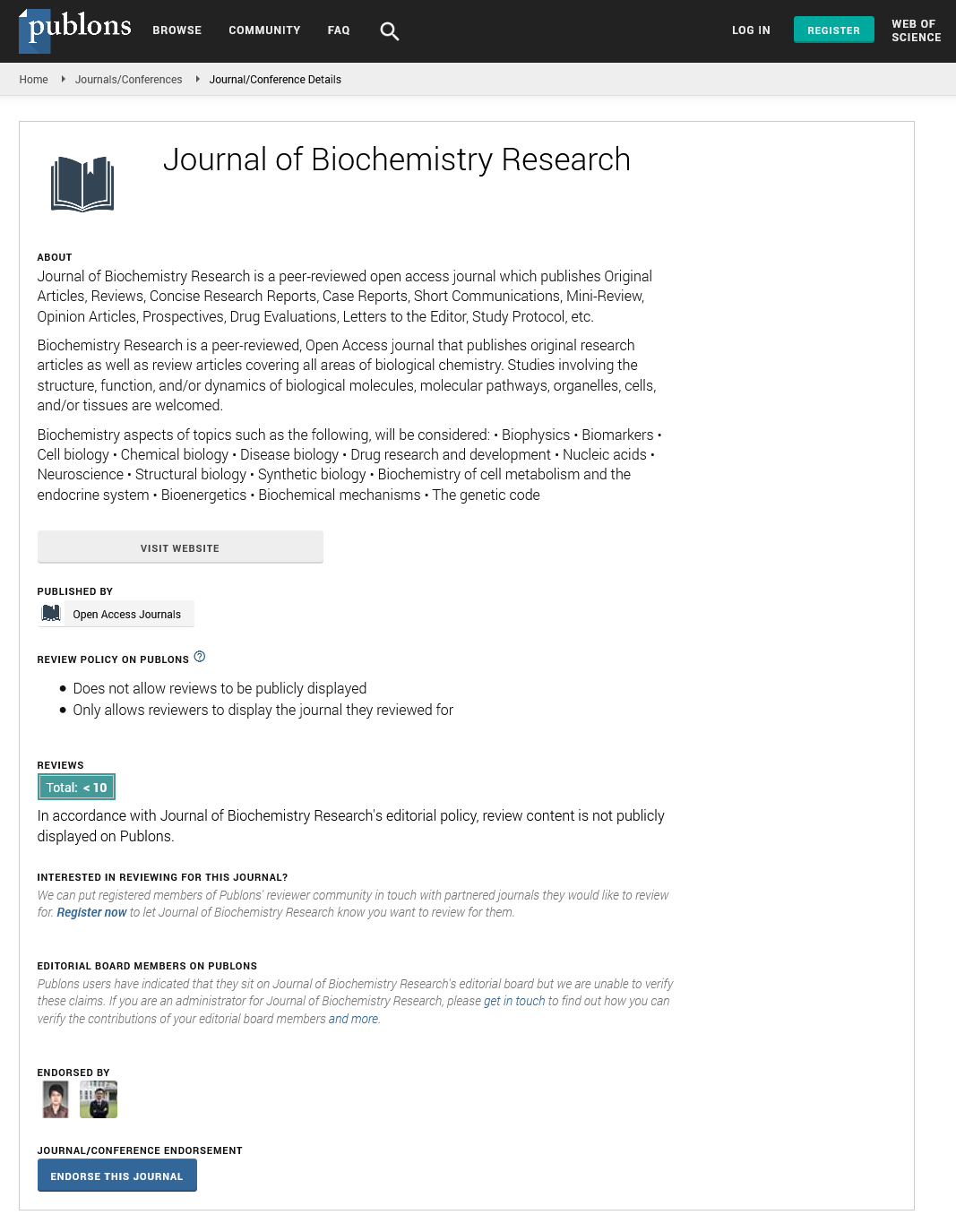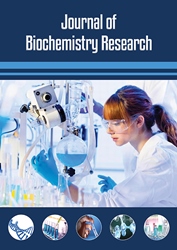Short Article - Journal of Biochemistry Research (2019) Volume 2, Issue 2
Mimetic Peptides based on Promiscuous Enzyme as Asymmetric Catalyst in Aldol and Michael Reactions
Saadi Bayat
Universiti Putra Malaysia, Malaysia
Abstract
Biocatalysis has developed as a rich and green apparatus for present day natural blend because of its high productivity, great selectivity and ecological worthiness. Although, an enzyme is capable of catalyzing a specific reaction effectively, some unexpected experimental results have indicated that many enzymes are catalytically promiscuous. Mimetic peptides based on enzyme as a kind of important chiral scaffold are broadly identified for their obvious advantages, diverse structures and ready accessibility. Based on promiscuous aldo-keto-reductase enzymes, several mimetic peptides were designed which were synthesized and tested as multifunctional organocatalysts in direct asymmetric aldol and Michael reactions. The asymmetric aldol and Michael reactions, as the most prominent carbon-carbon bond formation reactions, are the central study issues in the field of asymmetric synthesis. In this study, promiscuous aldo-ketoreductase (AKR) is used to catalyze aldol reaction between aromatic aldehydes and ketones. Great yield (up to 75%), moderate enantioselectivity (60%), and high diastereoselectivity (dr) up to 93/7 (against/ syn) were gotten. Several mimetic peptides from AKR’s site were designed and synthesized as asymmetric catalysts within the aldol and Michael reactions. The relating aldol items were delivered with exceptional returns (up to 97%) and magnificent diastereoselectivities (up to 99/1) and enantioselectivities (up to 99.9) under gentle response conditions. These peptides exhibit excellent catalytic activity in terms of yield, diastereoselectivity and enantioselectivity. The secondary structures of peptide catalysts provide an understanding of their mechanism.
The asymmetric aldol and Michael reactions, because the most prominent carbon-carbon bond formation reactions, are the central study issues within the field of asymmetric synthesis. during this study, promiscuous aldo-ketoreductase (AKR) wont to catalyze chemical reaction . between aromatic aldehydes and ketones. Good yield (up to 75%),moderate enantioselectivity (60%), and high diastereoselectivity (dr) up to 93/7 (anti/syn) were obtained. Several mimetic peptides from AKR’s site were designed and synthesized as asymmetric catalysts within the aldol and Michael reactions. Mimetic peptides PE16aa (1), PH16aa (2), 16aa (3), 8aa (4), 8aa-z (5), 5aa (6), 3aa (7), Fmoc-KLH-R (8), K(z)LH-R (9), PYE (10), PEY (11), PHE (12), PEH (13),LFV (14) 4a and 4b were successfully
synthesized using manually solid phase peptide synthesis protocol. Then, all of those mimetic peptides were employed to catalyze aldol reactions and peptides 2, 4, 4a, 4b, 10, 11, 12, and 13 were selected to catalyze Michael reactions. within the aldol and Michael reactions, peptide 4 exhibited the simplest results (up to 97% yield, up to 99.9% ee and dr up to 99/1). Peptide 1 produced an honest yield (88%), moderate enantioselectivity (68%), and excellent diastereoselectivity (dr = 99/1). Peptide 2 afforded the specified anti aldol product in 95% yield, 86% ee and 95/5 dr. Peptide 3 exhibited moderate yield (67%) but poor enantioselectivity (39% ee). Peptide 5 showed good catalytic activity and produced high yield (89%) and enantioselectivity (86%). Pentapeptide 6 catalyzed chemical reaction in high diastereo-and enantioselectivity (dr = 99/1 and 90% ee). PHE showed the simplest reactivity and selectivity amongst four tripeptides (PYE, PEY, PEH, PHE) up to 94% ee and up to 95/5 dr. Peptide 2 afforded corresponding Michael reaction up to 89% yield, 44% ee, and 99/1 dr. Peptide 4 generated desired Michael product up to 95% yield, 84% ee and 95/5 dr. Mechanism study demonstrated that enamine intermediate and hydrogenbonding interaction are vital for obtaining high enantiomeric excess. The reusability of peptide 4 because the best catalyst was also conducted for 10 times. Peptide 4 during a position|is ready"> is in a position to hydrolysis esters in a good to excellent yields of up to 99.7 %. All mimetic peptides displayed to move in terms of reactivity and selectivity in c-c bond forming reactions.
The perfect collagen peptide mimetics that have potential helpful worth ought to be unequipped for self-get together to the collagen triple helix, however ought to be capable The collagen mimetic peptides joining Flp deposits tie firmly to mammalian collagen and mouse wounds ex vivo. Raines and coworkers have synthesized a collagen peptide mimetic, Ac-(flp-Flp-Gly)7-(Gly–Ser)3-LysOH with lysine because the end group, the ε-amino group of which may be conjugated with various fluorophores or drug candidates through amide bond formation. Utilizing fluorophore-conjugated peptide mimetics, Raines and collaborators exhibited the solid restricting liking of this fluorinated peptide mimetic at the injury site, and facilitates the event of collagen-based biomaterials useful in skin grafting and restorative procedures.
Anti-Atherogenic Effects of apoA-I Mimetic Peptides The interest in mimetic peptides was greatly stimulated by the observation that 4F, in contrast to 2F, significantly reduces atherosclerosis in animal models, including apoE- and LDL receptor (LDLR)- deficient mice. 4F is especially effective in modulating early lesion development but is far less effective on more mature lesions. However, it's been suggested that 4F may synergize with statins in modulating the more advanced lesions. The peptide synthesized with natural L-amino acids (L-4F) was effective when administered intraperitoneally, subcutaneously, or intravenously. However, L-4F wasn't stable when administered orally, presumably thanks to its susceptibility to proteolysis within the intestinal lumen. This problem was circumvented by fabrication of the peptide with D amino acids. Many of the in vitro physical and biological properties of D-4F and L-4F are similar. In contrast to L-4F, D-4F was antiatherogenic upon oral administration. additionally , it has been reported that L-4F are often stabilized against proteolysis when fed in conjunction with niclosamide. Several other members of the 2F-related peptides have also been shown to attenuate atherosclerosis in animal models. None of those peptides reduce plasma lipid levels, indicating that other mechanisms account for his or her anti-atherogenicity.
As the notable biological effect of the mimetic peptides, especially 4F, is to significantly reduce atherosclerosis, it's not surprising that focus should pass to the cellular mechanisms which will help to account for this anti-atherogenic effect. Currently we don't fully understand the mechanism(s) by which the peptides reduce atherosclerosis. Among the properties of HDL/apoA-I that are extensively explored with reference to the function of the mimetic peptides are the power to market cholesterol efflux (the initiative within the process of reverse cholesterol transport) and therefore the attenuation of inflammation and oxidation. within the remainder of this chapter we review a number of the studies that are performed in vitro and in vivo to assess the potential antiatherogenic actions of the peptides.


